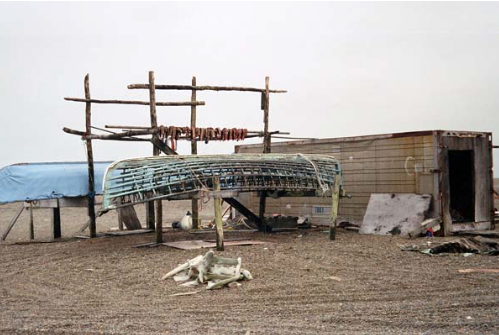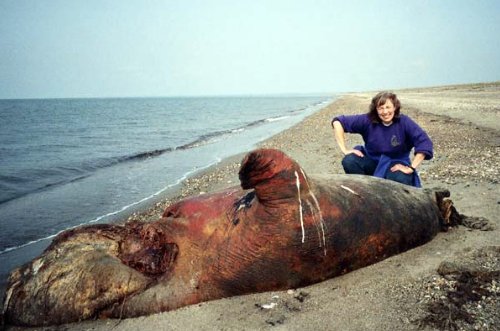Returning from a Walrus Hunt
The skiff touched the rocky beach as the captain and his nephew hopped out. Water lapped at their feet as they steadied the boat so the others could get out. The buzz grew louder as four wheelers brought friends and family to the beach.

When they arrived, some grasped the sides of the boat while the others started to unload. The captain grabbed the top item, a head with ivory tusks still attached, while his nephew pulled out the next one – the kumiyaw or back of the neck, and the most tender part of the skin. Everyone helped — someone got the coak (chest skin with attached blubber) while others unloaded the red meat (shoulder blades, ribs and ham, next to the hind flippers), organs (heart, liver and stomach, a lucky bonanza since it was filled with shellfish) and flippers and laid them out on the ice. Finished, the men dragged the empty boat above the tideline.
Everyone admired the catch. Not like it used to be but not bad. Walrus meat was a staple — like “hamburger” — and sorely missed when absent. Along with other Native foods, it reinforced both their heritage and connected them to the world around them.
Each crew member set aside a portion of the harvest to feed his family. They then distributed the rest: first to elders, then widows, and then other residents. They’d even save some to send to relatives and friends in Nome and Anchorage. According to ancient Eskimo philosophy, sharing among all beings made survival possible. Nobody would be forgotten.
Learn more…
How big is Native Alaskan demand for traditional foods?
Overall, demand for Alaska’s traditional foods remains small. In contrast, other subsistence hunting cultures face growing demand for their traditional foods. For example, in Central Africa’s rainforest, markets for bushmeat have grown so lucrative that poachers now threaten the species’ survival. Alaska’s walrus face a parallel threat as ivory, instead of its meat, becomes more and more profitable.

